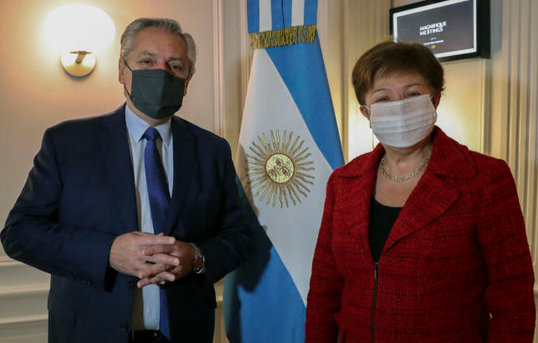Luego de meses de negociaciones, el presidente Alberto Fernández anunció el 28/01/22 que Argentina llegó a un acuerdo de crédito con el Fondo Monetario Internacional que le permitirá al país acceder a un nuevo financiamiento y ganar tiempo para pagar su deuda de USD 44.500 millones.

Sin este nuevo acuerdo, Argentina se habría enfrentado a pagos, entre capital e intereses, de más de USD 9 mil millones en 2022, tanto en 2023, como de USD 4 mil millones en 2024. Totalmente insostenible, y el país habría sido declarado en concurso de acreedores el 02/01/22.
Argentina se ha comprometido a reducir lentamente su déficit fiscal y cortar el financiamiento del Tesoro por parte del Banco Central como parte de un programa económico acordado con el FMI. El acuerdo también le daría a Argentina al menos un período de gracia de cuatro años y medio antes de comenzar a pagar su deuda.

Según representantes argentinos, los puntos clave del acuerdo son los siguientes:
1/ Argentina apuntará a un déficit fiscal primario de 2,5% en 2022, 1,9% en 2023 y 0,9% en 2024,
2/ Planes para reducir la asistencia del Banco Central al Tesoro a 1% del PIB en 2022, 0,6% en 2023 y “casi cero” en 2024,
3/ Argentina continuará con la política cambiaria vigente, sin grandes saltos devaluatorios,
4/ El plan apunta a USD 5 mil millones en reservas extranjeras adicionales en 2022,
5/ Gobierno no buscará reforma laboral ni privatizará empresas públicas,
6/ Argentina continuará con el control de precios como parte de su estrategia de inflación,
7/ El Plan también apunta a tasas de interés reales positivas.
El acuerdo necesita ser aprobado por el Congreso así como por la junta directiva del FMI. En resumen, Argentina ha hecho con el FMI lo mismo que hizo en 2020 con los acreedores privados: empujar la pelota un poco más adelante. Continuará…
